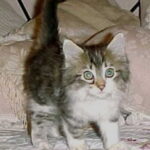While it’s considered rare in cats, hip dysplasia can make life miserable for your cat if it develops. Kittens as young as four months old can show signs of this disabling condition.
Overview
According to PetPlace.com, hip dysplasia refers to the abnormal development of a cat’s hip joint and problems from the resulting deformity.
This disorder has both genetic and environmental causes. For your cat to develop it, both of his or her parents must carry the defective gene even though neither showed any signs of it. Breeds with heavy bones, such as Persians and Maine Coon cats, have a propensity for this problem.
Environmental risks include type of diet, weight gain and rate of growth. Any of them can result in abnormal hip development. The end result for your cat could be arthritis, loss of range of motion, pain or all three.
Signs and Symptoms
PetMD indicates that a cat’s symptoms are a direct result of the degree of joint looseness, joint inflammation and duration of the disorder. During early disease, all symptoms link to joint looseness or laxity. However, in later stages, the signs are related to join degeneration and osteoarthritis.
The primary sign of dysplasia in cats is decreased activity. Your pet might have difficulty getting up or act reluctant to run, jump or climb stairs. Many cats display lameness, sometimes on an intermittent basis, that gets worse after any exercise. Some have a swaying gait or back legs that are unusually close together.
Pain in the hip joint is a major symptom. Some cats experience a grating whenever the hip joint moves and have a decreased range of motion. Loss of muscle mass in the thighs is common. As a result of extra weight bearing on your cat’s front legs to shift the burden from the hips, his or her shoulder muscles might enlarge.
Diagnosis and Treatment
Veterinarians begin by conducting a complete physical examination. This includes a blood chemical profile, complete blood count, electrolyte panel and urinalysis. Sometimes signs of inflammation appear in the blood work.
The point of taking a health history – even if the cat is a kitten – is to rule out any injuries that might have caused your pet’s symptoms. Gathering information for this history might also reveal physical problems linked to the cat’s parents. X-rays often provide sufficient additional information to make a diagnosis.
No treatment can reverse the abnormal hip joint development already in progress. However, a variety of options can usually make cats more comfortable and improve mobility. The type of treatment selected depends on your cat’s size, age, severity of joint looseness, extent of osteoarthritis, the vet’s preference and your financial situation.
Physiotherapy refers to passive joint motion. This exercise can cut joint stiffness and help maintain the integrity of your cat’s muscles.
Weight control is essential to all cats suffering from hip dysplasia.
Medications typically include anti-inflammatory drugs to reduce inflammation and swelling. Vets also sometimes prescribe pain medications.
Surgery is the appropriate treatment for many cats with hip dysplasia. Depending upon your cat’s circumstances, the vet will select one of four types. Total hip replacement has a 90-percent success rate and is appropriate for cats that don’t respond positively to medical therapy. Since this type of surgery is very expensive, a femoral and neck excision to reduce pain and improvement movement is an alternative for some cats. The other two procedures – triple pelvic osteotomy and juvenile pubic symphysiodesis – also carry a success rate of around 90 percent but are limited to kittens.
Post-operative appointments are necessary to check how your cat is healing. Good home care includes restricting a cat from cement floors, restraining attempts to become overly active during recovery from surgery and making sure any medications get administered on schedule. If your pet has been diagnosed with hip dysplasia, it’s important that you no longer breed the cat because the disorder is acquired genetically.
Sources:
http://www.petplace.com/cats/hip-dysplasia-in-cats/page1.aspx
http://www.petmd.com/cat/conditions/musculoskeletal/c_ct_hip_dysplasia










